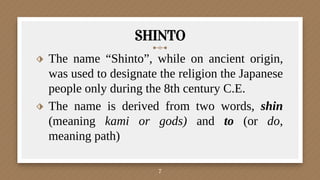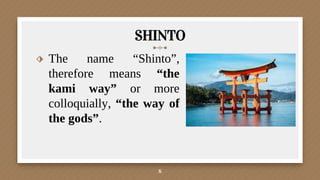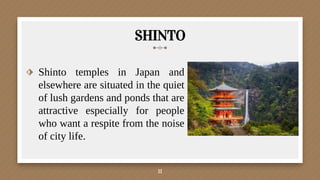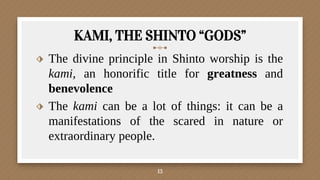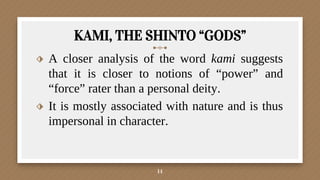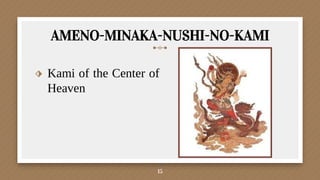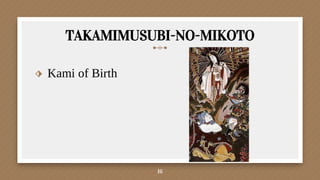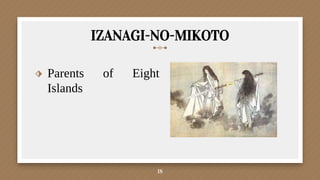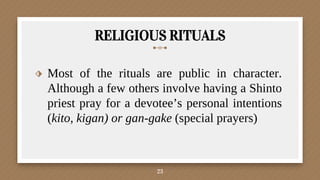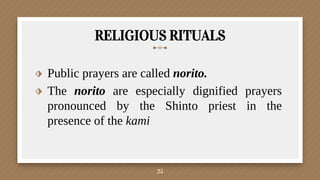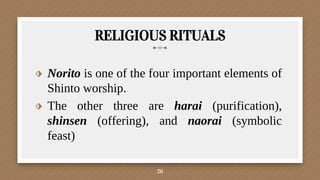Chapter 8 Shinto.....................pdf
- 2. LIFE PERFORMANCE OUTCOME I am a courageous, resourceful explorer and problem solver demonstrating my creativity and charism. 2
- 3. ESSENTIAL PERFORMANCE OUTCOME Search voluntarily beyond readily available sources of information, resources, and standard techniques to generate new understandings towards workable solutions to existing problems. 3
- 4. INTENDED LEARNING OUTCOME Search voluntarily beyond readily available sources of information about the basic beliefs and practices in Shinto. 4
- 5. WHAT I KNOW ABOUT SHINTO? Activity
- 7. SHINTO Ō¼Ś The name ŌĆ£ShintoŌĆØ, while on ancient origin, was used to designate the religion the Japanese people only during the 8th century C.E. Ō¼Ś The name is derived from two words, shin (meaning kami or gods) and to (or do, meaning path) 7
- 8. SHINTO Ō¼Ś The name ŌĆ£ShintoŌĆØ, therefore means ŌĆ£the kami wayŌĆØ or more colloquially, ŌĆ£the way of the godsŌĆØ. 8
- 9. SHINTO Ō¼Ś Prior to the 8th century it is believed that it had no name at all, because of the rise of Buddhism and Confucianism from China, it was necessary to distinguish this mode of religious practice. 9
- 10. SHINTO Ō¼Ś Shinto is quite unique because it is nature- centric. Ō¼Ś Shinto does not recognize any book as its authoritative scriptures, focusing instead on temple worship and the maintenance of the beauty of nature. 10 https://youtu.be/RWCSOzbdNoQ
- 11. SHINTO Ō¼Ś Shinto temples in Japan and elsewhere are situated in the quiet of lush gardens and ponds that are attractive especially for people who want a respite from the noise of city life. 11
- 13. KAMI, THE SHINTO ŌĆ£GODSŌĆØ Ō¼Ś The divine principle in Shinto worship is the kami, an honorific title for greatness and benevolence Ō¼Ś The kami can be a lot of things: it can be a manifestations of the scared in nature or extraordinary people. 13
- 14. KAMI, THE SHINTO ŌĆ£GODSŌĆØ Ō¼Ś A closer analysis of the word kami suggests that it is closer to notions of ŌĆ£powerŌĆØ and ŌĆ£forceŌĆØ rater than a personal deity. Ō¼Ś It is mostly associated with nature and is thus impersonal in character. 14
- 15. AMENO-MINAKA-NUSHI-NO-KAMI Ō¼Ś Kami of the Center of Heaven 15
- 16. TAKAMIMUSUBI-NO-MIKOTO Ō¼Ś Kami of Birth 16
- 17. KAMI-MISUBI- N0-MIKOTO Ō¼Ś Kami of Growth 17
- 18. IZANAGI-NO-MIKOTO Ō¼Ś Parents of Eight Islands 18
- 20. SUSANO-O-NO-MIKOTO HEAVEN Ō¼Ś Kami of The High Plain of Heaven 20
- 21. TSUKIYOMI-NO-MIKOTO Ō¼Ś Kami of The High Plain of Heaven 21
- 22. RELIGIOUS RITUALS Ō¼Ś Sometimes done at home, but in temples the priest takes the primary role as ritual expert, officiating the act of worship of the kami by offering it honor 22
- 23. RELIGIOUS RITUALS Ō¼Ś Most of the rituals are public in character. Although a few others involve having a Shinto priest pray for a devoteeŌĆÖs personal intentions (kito, kigan) or gan-gake (special prayers) 23
- 24. RELIGIOUS RITUALS Ō¼Ś Prayer for well-being Ō¼Ś For health and long life Ō¼Ś For success in work Ō¼Ś For happy relationships Ō¼Ś For safe journeys 24
- 25. RELIGIOUS RITUALS Ō¼Ś Public prayers are called norito. Ō¼Ś The norito are especially dignified prayers pronounced by the Shinto priest in the presence of the kami 25
- 26. RELIGIOUS RITUALS Ō¼Ś Norito is one of the four important elements of Shinto worship. Ō¼Ś The other three are harai (purification), shinsen (offering), and naorai (symbolic feast) 26
- 27. GRAND SHRINE OF ISE (ISEJINGU) Ō¼Ś Currently designed as the highest Shinto temple in terms of importance 27






